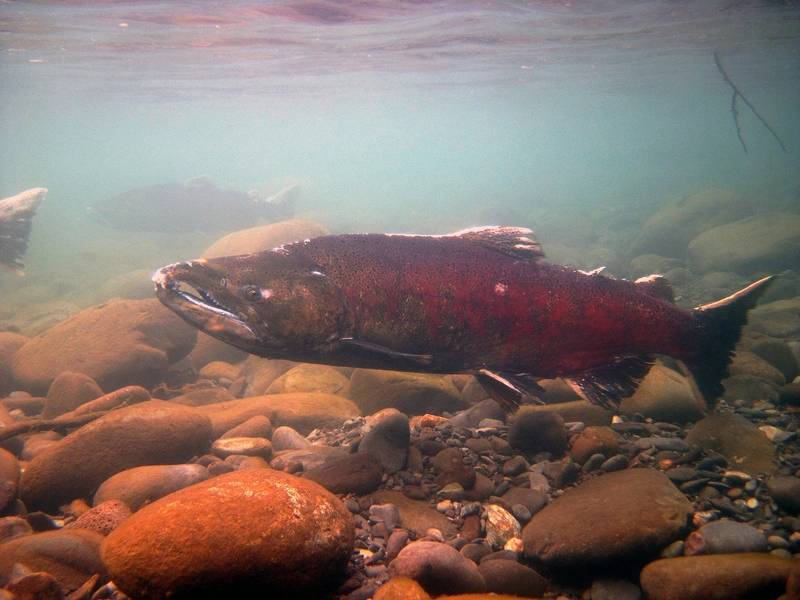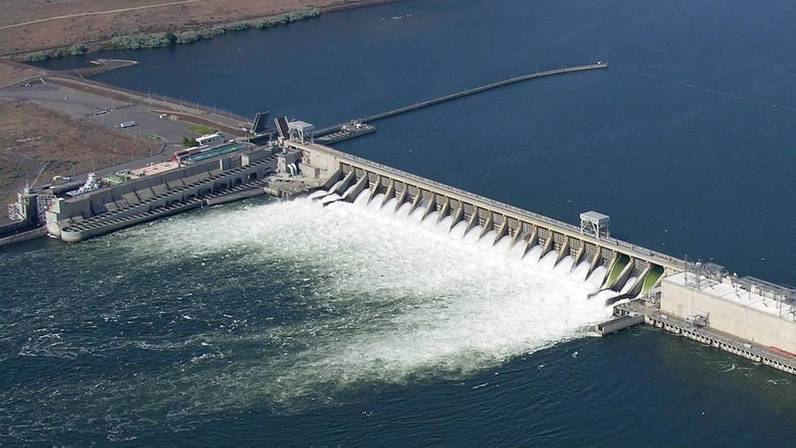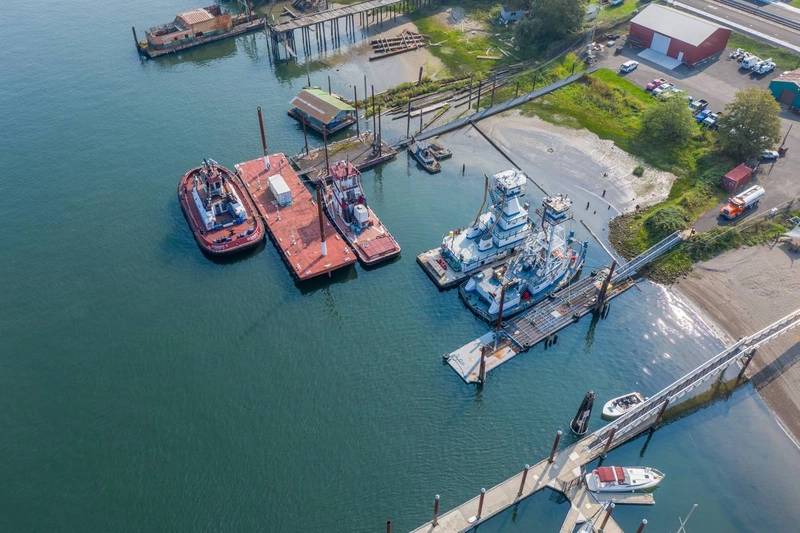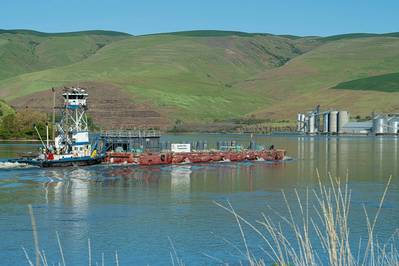Inland Waterways Focus: The Pacific Northwest Columbia-Snake River System
"The Columbia River and its tributaries, wetlands, and estuaries are the lifeblood of the Pacific Northwest, providing abundant water, power, recreation, agriculture, transportation and natural resources that have supported livelihoods, cultural and spiritual practices, commerce and economic growth.” - President Biden, Memorandum of September 27, 2023.
Those abundant benefits directly impact about 13 million people in the Pacific Northwest. Hydropower extends that plentitude to millions more, powering cities and industry from Idaho to California. Transportation extends the Northwest’s agricultural wealth worldwide, first via barge transport on the Columbia-Snake River System (CSRS) and then to ocean ports.
But these social and economic successes have had consequences, and of top concern right now is whether decades of hardscape engineering – particularly the four Snake River dams – have placed Columbia River Basin salmon, steelhead and other native fish at the brink of extinction, an unthinkable outcome in the Pacific Northwest.
 (Credit: John McMillan / NOAA)
(Credit: John McMillan / NOAA)
To prevent that ecological disaster the President’s Council on Environmental Quality (CEQ) and six Pacific Northwest Tribes, as well as the States of Oregon and Washington, signed an Agreement in December to establish programs and conditions to ensure not just salmon recovery, but abundance. Next steps could include breaching the dams: Ice Harbor, Lower Monumental, Little Goose and Lower Granite. Many people ask: why shouldn’t the dams be breached if related benefits – e.g., energy, transport, irrigation, transmission services – can be alternately provided?
This fishery-ecology concern is at the core of the President’s memo which directs federal officials to establish policies that will ensure the long-term survival of salmon and native fish, to ensure that this wildlife “metric” is held to be just as critical (at least) as statistics about energy or transport or agriculture.
The memo established an all-of-government approach, requiring coordinated work among federal agencies, including NOAA and the U.S. Army Corps of Engineers (USACE), six tribal nations—referred to as the Six Sovereigns—and the states of Oregon and Washington (U.S. Census Bureau 2022 data estimates the American Indian population in Washington and Oregon was 150,000). The memo sets a fast timeline: by the end of January agencies were to have evaluated an “intergovernmental partnership” and to report to the President on how that partnership was progressing. By May, agency heads have to present programs to “restore health and abundant salmon, steelhead, and other native fish populations.”
But there’s more to this; a lot more. Many people believe that there’s no choice, that the only sustainable way forward, at least for salmon and native fish, requires breaching. It’s charged that the dams, no matter how they are configured to help with migration, block and trap salmon struggling to move from inland spawning grounds to the ocean and back. Salmon and other species need cool, fast running clear water, not tepid, relatively stagnant and turbid lakes and waterways.
The dams, though, are foundational for the Northwest’s abundance. Therefore, the President’s memo additionally requires that federal agencies, the Six Sovereigns and the two states, “informed by Indigenous Knowledge,” develop solutions, for –
- “clean and resilient energy,”
- local agriculture and “its role in food security domestically and globally,” and
- investments for “the communities that depend on the services provided by the Basin’s Federal dams.”
This is where the work gets difficult, of course, very difficult, not to mention contentious and expensive. Barging on the inland Columbia Snake River System moves, on average, approximately 10 million tons of cargo valued at over $3 billion annually. Forty percent of US wheat transits through this system. The Pacific Northwest Waterways Association estimates it would take 162,153 semis or 42,160 rail cars to move Snake River freight. A 2022 Bonneville Power Administration study estimated it would cost between $415 million and $860 million per year until 2045 to replace the dams’ hydroelectric power with solar and wind.
In fact, with energy (carbon free energy, it’s important to point out) the four dams play an outsized role. The Army Corps explains that because of location, size and ability to help meet peak power loads the four dams are key to system reliability, including supporting wind energy. The Snake River dams lie east of the other federal generators, the Corps explains, and that siting provides a significant technical contribution to transmission grid reliability.
 Spill through two raised spillway weirs (right) and conventional spillways at McNary Dam on the lower Columbia River improves downstream passage survival for juvenile salmon and steelhead.
Spill through two raised spillway weirs (right) and conventional spillways at McNary Dam on the lower Columbia River improves downstream passage survival for juvenile salmon and steelhead.
Spill through two raised spillway weirs (right) and conventional spillways at McNary Dam on the lower Columbia River improves downstream passage survival for juvenile salmon and steelhead. (Credit: USACE)
Concurrent to work on the President’s memorandum was a release in December of a 92-page agreement between the White House Council on Environmental Quality (CEQ), the Six Sovereigns and the two states. The agreement has three main parts:
- A memorandum of understanding in which the parties agree to hold off on CSRS litigation for at least 5 years, maybe 10, depending on progress, and a U.S. government commitment of resources to support proposals within a “Columbia Basin Restoration Initiative (CBRI)” developed by the Six Sovereigns and two states;
- An Attachment 1 details the CRBI’s plans and recommendations; and,
- An “Attachment 2” detailing further how the U.S. government will support the CBRI.
For the Six Sovereigns and Oregon and Washington it’s a given within the CBRI that the four lower Snake River dams need to be breached, will be breached. The document references a NOAA report that full salmon recovery “will require breaching the four Lower Snake River dams.” Elsewhere the CBRI writes of the need to “replace the benefits of the dams with due urgency to enable breaching to move forward”.
The rest of the federal government is not quite so confirmatory. Its position is that decisions about breaching will be made during the next few years, as commitments within the Agreement provide further analysis and information. Indeed, breaching may not be possible or advisable and salmon recovery will have to depend on other efforts. Still, for the U.S., breaching is a possibility and maybe even likely.
The Six Sovereigns and Oregon and Washington write that “we must act now to invest in replacing the dams’ benefits in order to make breaching a viable policy action”. This proactive advisory comports with the President’s memo: develop sustainable native fishery solutions and prepare to replace other related benefits, from transportation to irrigation to energy. Replacement power is to be provided by “new, clean Tribally-sponsored energy” projects. It’s believed that when those alternatives are in place the dams won’t be needed and the salmon runs, from the Pacific to high mountain streams, will revert to a wild but supportive riverways and riparian landscapes.
Importantly, on a federal system, only Congress can authorize breaching dams. In January, the U.S. House Energy and Commerce Committee held a hearing on the Six Sovereigns two States Agreement. It was contentious, rather predictably along party lines. Republican members almost goaded administration officials with the question: when will you breach the four dams? Democrats repeated, exasperatedly: there has been no decision to breach; that’s what the agreement is for—to evaluate all options.
Another Republican concern was that the agreement resulted from an exclusive process among selective participants already biased towards breaching. Not true, CEQ Chair Brenda Mallory pushed back: participants represented a range of interests. But that assertion was challenged. Jim Matheson, CEO of the National Rural Electric Cooperative Association, for example, said, yes, the process started with the proverbial big tent, but participation winnowed, and just a few people and groups were involved in final decisions and signoffs.
It might be tempting to view this latest activity as yet another round of studies and obligatory meetings. After all, dam-salmon litigation started 30 years ago. But, like the President’s memo, the CBRI includes hammer dates, based on the notion that salmon and native fish have run out of time, demanding action now.
 © Reagan / Adobe Stock
© Reagan / Adobe Stock
The Six Sovereigns and Oregon and Washington suggest that replacement services—from energy to agriculture to transport—should be in place “within 8-10 years to allow dam breaching to move forward with certainty”. This work has started. Some examples: a DOE analysis of replacement power was due February 1, 2024. However, that deadline was missed. A CEQ spokesperson said, “Discussions on accounting for replacement power are ongoing.”
In “early 2024” watch for a transportation summit to address necessary “rail, road and culvert upgrades”. The Army Corps is to “analyze what other transportation infrastructure, including rail, could provide regional benefits and also replace services should Congress authorize dam breach”. Deadline: “late-2024”. When asked about the deadline, USACE said it will undertake studies if Congress authorizes such work.
The agreement goal is to have all analytical work completed by the end of 2024. Information will then be presented to Congress along with requests for program authority and money. Stay tuned.












